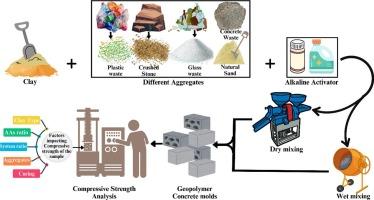Compressive strength of clay-based geopolymers: A concise review of the influencing factors and underlying mechanisms
IF 5.8
2区 地球科学
Q2 CHEMISTRY, PHYSICAL
引用次数: 0
Abstract
Geopolymer is a green inorganic polymer that is produced by using aluminosilicate materials, such as clay materials and industrial by-products in a highly alkaline environment. In recent years, clay had been widely used in the manufacturing of ceramics and building construction. The use of clay in geopolymer production not only reduces the environmental impact of traditional cement production, but also provides a sustainable alternative for various construction applications. Its versatility and cost-effectiveness make it an attractive option for industries looking to reduce their carbon footprint. This review is mainly focused on factors that influence the strength of clay-based geopolymers. Several factors, such as clay type, alkaline activator solution, aggregates, system ratio, curing temperature and time were discussed. The review also included mechanism of geopolymerization reaction. Overall, a combination of the appropriate clay type, aggregates, curing conditions, and activator solution is essential in achieving a high strength in geopolymers. Additionally, emerging reinforcement strategies such as nanomaterials, hybrid binders and fiber reinforcements are also discussed in context of mechanical behaviour of clay-based geopolymer.

粘土基地聚合物的抗压强度:影响因素和潜在机制的简要综述
地聚合物是一种在高碱性环境下,利用粘土等铝硅酸盐材料和工业副产品生产的绿色无机聚合物。近年来,粘土被广泛应用于陶瓷制造和建筑施工中。在地聚合物生产中使用粘土不仅减少了传统水泥生产对环境的影响,而且为各种建筑应用提供了可持续的替代方案。它的多功能性和成本效益使其成为寻求减少碳足迹的行业的一个有吸引力的选择。本文主要综述了影响粘土基地聚合物强度的因素。讨论了粘土类型、碱性活化剂溶液、集料、体系比、养护温度和养护时间等因素。综述了地聚合反应的机理。总的来说,适当的粘土类型、骨料、养护条件和活化剂溶液的组合对于实现高强度地聚合物是必不可少的。此外,新兴的增强策略,如纳米材料,杂化粘合剂和纤维增强也在粘土基地聚合物的力学行为的背景下进行了讨论。
本文章由计算机程序翻译,如有差异,请以英文原文为准。
求助全文
约1分钟内获得全文
求助全文
来源期刊

Applied Clay Science
地学-矿物学
CiteScore
10.30
自引率
10.70%
发文量
289
审稿时长
39 days
期刊介绍:
Applied Clay Science aims to be an international journal attracting high quality scientific papers on clays and clay minerals, including research papers, reviews, and technical notes. The journal covers typical subjects of Fundamental and Applied Clay Science such as:
• Synthesis and purification
• Structural, crystallographic and mineralogical properties of clays and clay minerals
• Thermal properties of clays and clay minerals
• Physico-chemical properties including i) surface and interface properties; ii) thermodynamic properties; iii) mechanical properties
• Interaction with water, with polar and apolar molecules
• Colloidal properties and rheology
• Adsorption, Intercalation, Ionic exchange
• Genesis and deposits of clay minerals
• Geology and geochemistry of clays
• Modification of clays and clay minerals properties by thermal and physical treatments
• Modification by chemical treatments with organic and inorganic molecules(organoclays, pillared clays)
• Modification by biological microorganisms. etc...
 求助内容:
求助内容: 应助结果提醒方式:
应助结果提醒方式:


